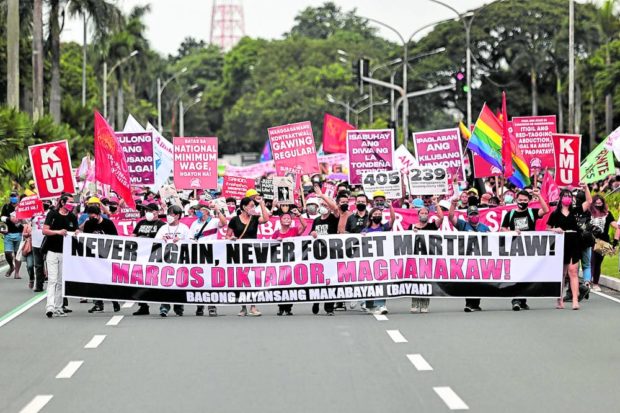ML at 50: Then and now, labor woes a kindling for unrest

Activists and human rights advocates take the battle against historical distortion to the streets as they mark the 50th anniversary of the declaration of martial law. (Photo by GRIG C. MONTEGRANDE / Philippine Daily Inquirer)
MANILA, Philippines — Filipino workers are confronting the same unjust conditions — low wages amid soaring prices of goods — that stoked civil unrest during the dictatorship of President Ferdinand Marcos Jr.’s late father, labor groups said on Wednesday as they marked the 50th anniversary of Ferdinand Marcos Sr.’s declaration of martial law.
Judy Ann Miranda, secretary general of Partido Manggagawa, warned that the downfall of the Marcos regime was triggered in part by troubling economic indicators that drove workers to the streets along with other sectors, culminating in the dictator’s ouster through the 1986 Edsa People Power Revolution.
“There was massive discontent by workers during the martial law period over low wages, high prices, insecure jobs, and employer abuse,” she recalled in a statement.
Debunking assertions by disinformation channels on social media, she said the declaration of martial law on Sept. 21, 1972, was a period of “labor militancy, and not of golden age” for the working class.
“Contrary to the fake news peddled by social media influencers and amplified by a paid army of trolls, martial law was not a time of happiness for Filipinos nor a period of economic prosperity,” Miranda said.
Golden age for Marcoses
Martial law, according to her, was a “golden age [only] for the Marcoses,” as the family and its cronies plundered the national treasury and took control of debt-financed development projects and key industries.
Also on Wednesday, the labor group Kilusang Mayo Uno (KMU) said working conditions during Marcos Sr.’s regime “are very similar” to the current situation under his son’s two-and-a-half-month-old presidency.
KMU chair Elmer Labog cited importation issues and lack of support in the local production of rice, salt and sugar on top of record-high inflation rates, the same economic problems that hounded the country in the 1970s and 1980s.
Labog challenged Marcos to address the workers’ demands by certifying as urgent bills on security of tenure and national minimum wage before his 100th day in office, or by Oct. 8.
“That has been a long-standing issue ever since your father’s administration,” he noted.
Bills establishing a national minimum wage for private sector workers and providing for security of tenure for contractual and job order employees are pending in House committees.
La Tondeña strike
As part of the Sept. 21 commemoration, KMU members staged a protest action at La Tondeña Distillery in Tondo, Manila, the site of the historic October 1975 strike, the first major strike held after the martial law declaration.
Labog paid tribute to the courage of the La Tondeña strikers who, he said, inspired other workers to stage over 70 subsequent strikes, pushing Marcos Sr. to ban them altogether.
KMU secretary general Jerome Adonis said there was no progress for workers’ rights even after 50 years.
“As prices continue to inflate, citizens have to line up for rice just to have something to eat, just like times under martial law,” he said.
After the declaration of martial law, the Philippine economy experienced growth in the first few years, with the gross domestic product (GDP) reaching a record 8.92 percent in 1973 and 8.81 percent in 1976.
Grim numbers
But the country also suffered its worst recession during that period, with the GDP shrinking by 7.3 percent in 1984 and 1985.
Inflation had been in single digits when Marcos Sr. came to power in 1966. By 1974, it was at 34.2 percent, before returning to manageable levels in the following years. It rose again to 17.5 percent in 1979 and peaked at 50.3 percent in 1984.
The country’s foreign debt by the end of Marcos Sr.’s rule had ballooned to $28.26 billion, from $360 million in 1961.
The value of the peso also slipped from P3.90 to $1 in 1965 to P19.03 by December 1985.
Unemployment stood at 4 percent in 1975, but 10 years later it reached 12.6 percent.
From 1965 to 1985, an official survey showed that poverty incidence rose from 11 percent in 1965 to 18.9 percent in 1985.
Based on data from the Martial Law Museum, the daily wage of Filipino farmers declined from 1972 to 1986 by about 30 percent.
The wages of skilled workers fell from P127 in 1972 to P35 in 1986, while wages for unskilled workers fell from P89 in 1972 to P23 in 1986.
—WITH A REPORT FROM INQUIRER RESEARCH
RELATED STORIES
Silence from the Palace on martial law’s 50th anniversary
CHR: Recall martial law so democracy will endure
‘Move on’: The shallowness of calls to bury martial law memories